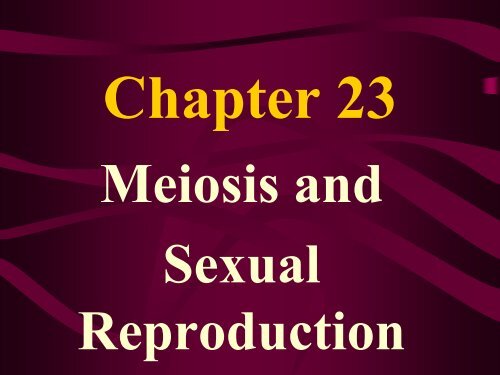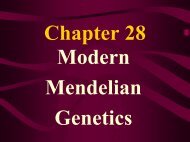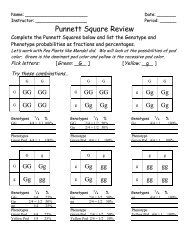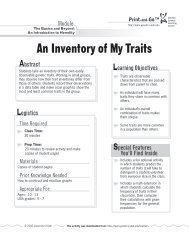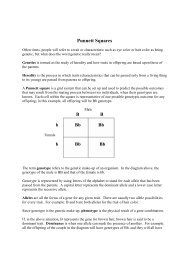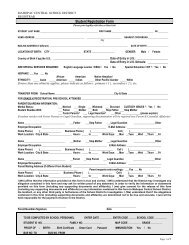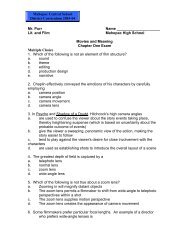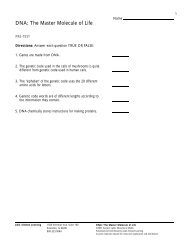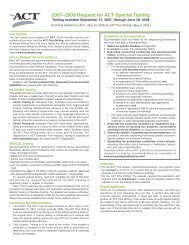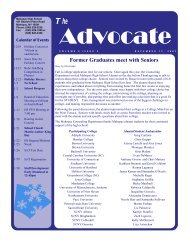Chapter 23
Chapter 23
Chapter 23
Create successful ePaper yourself
Turn your PDF publications into a flip-book with our unique Google optimized e-Paper software.
<strong>Chapter</strong> <strong>23</strong><br />
Meiosis and<br />
Sexual<br />
Reproduction
Asexual Reproduction<br />
(review)<br />
• Single parent gives rise to new<br />
offspring by mitotic cell division<br />
• Each new individual receives a set of<br />
chromosomes identical to the parent<br />
chromosomes<br />
• No variation of hereditary information
(I) Sexual Reproduction<br />
• Two parents give rise to new offspring by<br />
the fusion of nuclear materials from two<br />
different cells<br />
• Offspring are not identical to the parent<br />
• Variations exist, which increases the species<br />
ability to adapt to the changing<br />
environment
(A) Gonads<br />
• Sex organs<br />
1. Males – Testes<br />
2. Females – Ovaries
(A) Gametes<br />
• Sex cells<br />
1. Males – sperm<br />
2. Females – ovum
(B) Fertilization<br />
• The fusion of the nuclei of one<br />
sperm with one ova (egg) to<br />
produce a zygote<br />
• Sperm (n) + Ovum (n) =2n<br />
• Sperm (<strong>23</strong>) + Ovum (<strong>23</strong>) = 46
Fertilization and the Stages of<br />
Mitosis
(C) Haploid<br />
• Also known as monoploid<br />
• Represented by: n<br />
• The gametes contain half the number of<br />
chromosomes<br />
• Remember, gametes are sex cells that<br />
combine to form new offspring. Therefore<br />
gametes are haploid and once they fuse<br />
(combine), they form a zygote that is diploid
(D) Diploid<br />
• Contain the full number (set)<br />
of chromosomes<br />
• Represented by: 2n
Homologous Chromosomes<br />
• Pairs of similar chromosomes<br />
• Humans have 46 chromosomes:<br />
22 pairs of homologous chromosomes<br />
1 pair of sex chromosomes
(II) Meiosis<br />
• Known as Reduction Division<br />
• Meiosis is a type of cell<br />
division in which the daughter<br />
cell receives only half the<br />
number of chromosomes<br />
present in the parent cell
<strong>23</strong> Pairs of chromosomes of a human cell<br />
• The chromosomes<br />
labeled X and Y<br />
are the sex<br />
chromosomes<br />
• XX = female<br />
• XY = male
(III) Stages of Meiosis<br />
• In meiosis, each cell divides twice:<br />
1. The first stage is very similar to mitosis<br />
2. The second stage is also like mitosis<br />
with the exception that there is<br />
NO replication of chromosomes in the<br />
second phase (meiosis 2)
Phases of Meiosis<br />
First Division<br />
Prophase I<br />
Metaphase I<br />
Anaphase I<br />
Telophase I<br />
Second Division<br />
Prophase II<br />
Metaphase II<br />
Anaphase II<br />
Telophase II
Second Division
Meiosis
Key<br />
SS = single-stranded<br />
DS = double-stranded
First Meiotic<br />
Division
Prophase I<br />
• Replication of SS chromosomes<br />
into DS chromosomes has<br />
already occurred.<br />
• Each chromosome then pairs up<br />
with it’s homologous<br />
chromosome.<br />
• This is known as synapsis.
Prophase I<br />
• Each chromosome pair consists<br />
of 4 chromatids and thus is a<br />
tetrad.<br />
• Crossing over occurrs when<br />
segments of DNA are exchanged<br />
between the chromatids found in<br />
tetrads.
Metaphase I<br />
• Alignment of the tetrads (4<br />
chromatids) in the middle of the<br />
cell (equatorial plane).
Telophase I<br />
• Cytokinesis occurs as in Mitosis<br />
however each of the daughter cells<br />
has half the # of chromosome<br />
compared to the parent.<br />
• After this point, the chromosomes<br />
WILL NOT replicate.<br />
• Cells usually start prophase 2<br />
immediately after telophase 1.
Second<br />
Meiotic Division
Prophase II<br />
• Chromosomes DO NOT<br />
replicate.<br />
• DS chromosomes move<br />
towards the equatorial plane.
Metaphase II<br />
• Tetrads line up in the<br />
MIDDLE of the cell.<br />
• This is sometimes called the<br />
equatorial plane or the<br />
metaphase plate.
Anaphase II<br />
• DS chromosomes<br />
separate.<br />
• SS chromosomes move<br />
to opposite ends.
Telophase II<br />
• Both daughter cells undergo<br />
cytokinesis forming 4 haploid<br />
cells.<br />
• Thus, each cell has ½ the number<br />
of chromosomes as the parent.
Meiosis<br />
• Diploid (2n) cells divide<br />
haploid (n) cells<br />
These cells mature into specialized<br />
reproductive cells (sperm and ova).
(III) Sexual Reproduction<br />
in<br />
Animals
(A) Reproductive System<br />
• Gonads- specialized organs that<br />
produce gametes<br />
a) ovaries - female gonad<br />
- produce ova (egg)<br />
b) testes - male gonad<br />
- produce sperm cell
(B) Hermaphrodite<br />
• Contain both male and female<br />
reproductive structures
(C) Gametogenesis<br />
• Process by which gametes are<br />
produced in the gonads<br />
• Two types:<br />
Spermatogenesis<br />
Oogenesis
Spermatogenesis<br />
• Primary spermatocyte<br />
goes through first meiotic<br />
division and form two<br />
daughter cells of equal<br />
size<br />
• Each daughter cell<br />
(secondary spermatocyte)<br />
goes through the second<br />
meiotic division forming<br />
four motile sperm cells of<br />
equal size
• The primary oocyte goes<br />
through first meiotic<br />
division and the<br />
cytoplasm of the cell is<br />
divided unequally<br />
• The larger daughter cell<br />
is called the secondary<br />
oocyte and the smaller<br />
daughter cell is called the<br />
polar body<br />
• During second meiotic<br />
division, 1 mature ovum<br />
is produced and 3 polar<br />
bodies<br />
Oogenesis
Comparison of Ova and Sperm<br />
• Egg cells contain stored food in the<br />
form of yolk.<br />
• Egg cells are larger than sperm.<br />
• Sperm are motile, egg cells sessile<br />
(can’t move on their own).
Fertilization<br />
• Union of a haploid<br />
sperm nucleus with a<br />
haploid egg nucleus<br />
• This results in a<br />
diploid zygote with the<br />
full number of<br />
chromosomes
Fertilization<br />
• Union of a haploid<br />
sperm nucleus with a<br />
haploid egg nucleus<br />
• This results in a<br />
diploid zygote with the<br />
full number of<br />
chromosomes
Two types of Fertilization<br />
Internal Fertilization<br />
External Fertilization
Internal Fertilization<br />
• Takes place inside the body of<br />
the female<br />
• Less eggs are required<br />
Ex: mammals and birds
Internal Fertilization
External Fertilization<br />
• Eggs are fertilized outside the body of<br />
the female<br />
• Large number of eggs are required<br />
• This type of fertilization is found in<br />
an aquatic environment<br />
Ex: fish, frogs, & salamanders.
External Fertilization<br />
Typical amphibian habitat
External Fertilization<br />
Eastern spotted newt
External Fertilization<br />
Eastern spotted newt<br />
spots<br />
newt
External Fertilization<br />
An example of an “egg sac.”<br />
“egg sac’s” actually contain<br />
developing embryos.
External Fertilization<br />
Multiple “egg” sacs<br />
Near Bull’s Hill , NY<br />
“egg sac”<br />
Saccone
External Fertilization<br />
A frog and multiple “egg” sacs<br />
Near Bull’s Hill , NY
External Fertilization<br />
Another “egg” sac<br />
found near New Paltz, NY
External Fertilization<br />
Close-up of individual “frogs”<br />
developing (already fertilized)


